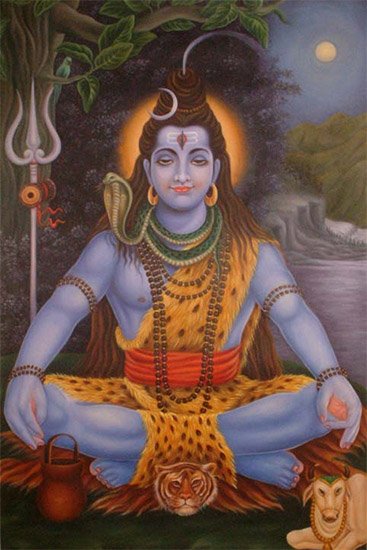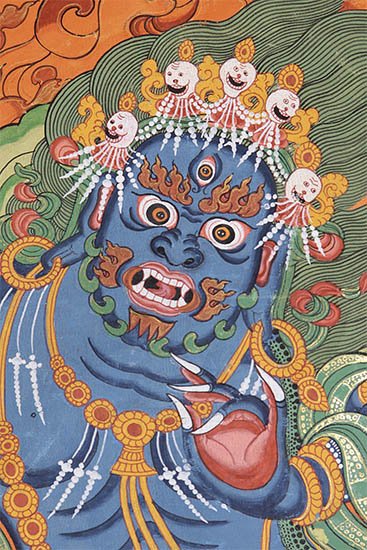Agnivaktra, Agnivaktrā: 3 definitions
Introduction:
Agnivaktra means something in Buddhism, Pali, Hinduism, Sanskrit. If you want to know the exact meaning, history, etymology or English translation of this term then check out the descriptions on this page. Add your comment or reference to a book if you want to contribute to this summary article.
In Hinduism
Shaivism (Shaiva philosophy)
Source: Wisdom Library: Kubjikāmata-tantra1) Agnivaktrā (अग्निवक्त्रा):—Sanskrit name for the tenth of the twenty-four goddesses of the Sūryamaṇḍala (first maṇḍala of the Khecarīcakra) according to the kubjikāmata-tantra. The Khecarīcakra is the fifth cakra (‘internal mystic center’) of the five (pañcacakra) and is located on or above the head. She presides over the pītha (‘sacred site’) called Airuḍī.
2) Agnivaktrā (अग्निवक्त्रा):—Sanskrit name for the twentieth of the twenty-four goddesses of the Sūryamaṇḍala (first maṇḍala of the Khecarīcakra) according to the kubjikāmata-tantra. She is also known as Agnivadanā according to the Ṣaṭsāhasraṭippanī, and Vahnyānanā according to the Kulamūla-ratnapañcakāvatāra, and Agnijvālā or Agnijihvā according to the Gorakṣa-saṃhitā. The Khecarīcakra is the fifth cakra (‘internal mystic center’) of the five (pañcacakra) and is located on or above the head. She presides over the pītha (‘sacred site’) called Sopāra.
Source: academia.edu: A Critical Study of the Vajraḍākamahātantrarāja (II) (shaivism)Agnivaktrā (अग्निवक्त्रा) is the name of a Goddess (Devī) presiding over Airuḍī: one of the twenty-four sacred districts mentioned in the Kubjikāmatatantra (chapter 22). Her weapon is the vajra and śakti. Furthermore, Agnivaktrā is accompanied by the Kṣetrapāla (field-protector) named Ghaṇṭārava. A similar system appears in the 9th century Vajraḍākatantra (chapter 18).
Agnivaktrā (अग्निवक्त्रा) is also mentioned as the Devī presiding over Sopāra; her weapon is the kaṭṭārikā and she is accompanied by Piśitāśa.

Shaiva (शैव, śaiva) or Shaivism (śaivism) represents a tradition of Hinduism worshiping Shiva as the supreme being. Closely related to Shaktism, Shaiva literature includes a range of scriptures, including Tantras, while the root of this tradition may be traced back to the ancient Vedas.
In Buddhism
Tibetan Buddhism (Vajrayana or tantric Buddhism)
Source: academia.edu: A Critical Study of the Vajraḍākamahātantrarāja (II)Agnivaktrā (अग्निवक्त्रा) or Piśitāsanā is the name of a Goddess (Devī) presiding over Sopāra: one of the twenty-four sacred districts mentioned in the 9th century Vajraḍākatantra (chapter 18). Her weapon is the kaṭṭārikā. Furthermore, Agnivaktrā is accompanied by an unmentioned Kṣetrapāla (field-protector) and their abode is a śālmali-tree.

Tibetan Buddhism includes schools such as Nyingma, Kadampa, Kagyu and Gelug. Their primary canon of literature is divided in two broad categories: The Kangyur, which consists of Buddha’s words, and the Tengyur, which includes commentaries from various sources. Esotericism and tantra techniques (vajrayāna) are collected indepently.
See also (Relevant definitions)
Full-text: Sopara, Ghantarava, Pishitashana, Pishitasha, Suryamandala, Airudi, Erudi.
Relevant text
No search results for Agnivaktra, Agnivaktrā; (plurals include: Agnivaktras, Agnivaktrās) in any book or story.